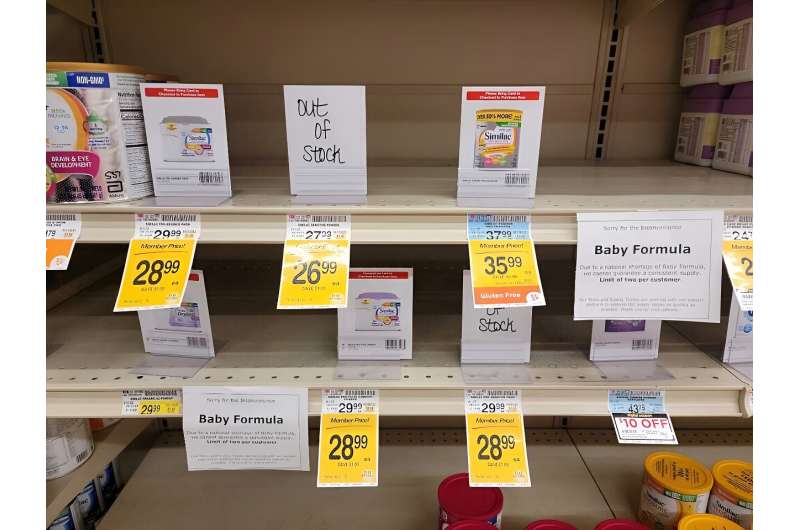This article has been reviewed according to Science X's editorial process and policies. Editors have highlighted the following attributes while ensuring the content's credibility:
fact-checked
trusted source
proofread
Q&A: Business expert shares insights from panel formed to examine infant formula crisis

Despite complex regulations for infant formula, contamination in production and supply chain issues at Abbott Nutrition created a dangerous shortage in 2022.
The nationwide shortage affected families across the country, particularly low-income households. In response, Congress directed the Food and Drug Administration to enter an agreement with the National Academies of Sciences, Engineering, and Medicine to study the challenges in supply, market competition and regulation of infant formula in the United States.
It assembled an international team of interdisciplinary experts to study critical vulnerabilities in the supply and regulation of infant formula. That team, which recently published their findings and recommendations, have identified risks exposed by the shortage and recommended improvements to the sector. The work is published in the journal National Academies Press.
Ravi Anupindi, vice chair of the study and professor at the University of Michigan's Ross School of Business, discusses their efforts and the overall landscape.
The study was a coalition of researchers in several fields. How did an interdisciplinary approach help uncover the challenges of infant formula shortages?
The research entailed understanding the infant formula sector from multiple angles: product and its intended uses; nutritional needs of infants; customer segments and their characteristics; understanding of the Special Supplemental Nutrition Program for Women, Infants, and Children program; end-to-end supply chain including raw materials and components, production, distribution and retail; roles of government agencies like the FDA, U.S. Department of Agriculture and the Department of Health and Human Services; regulatory and contracting processes; and crisis management.
Having a diverse team of experts in these areas allowed the committee and myself to develop a holistic understanding of the sector and its vulnerabilities.
How did your previous research on essential medical supply chains and operations influence this project? Were there any previous studies in which you discovered similar systemic challenges?
I have studied supply chain risk and resiliency issues for over 15 years across different industry sectors. I have previously written case studies on Cisco and Boeing on this topic. I have also been a member of the Supply Risk Leadership Council.
In the last few years, I worked on risk, resiliency and crisis-management issues. These include for the COVID-19 testing scale-up in Michigan, policies to secure health commodities at the national level, written testimony to the U.S. Senate Committee on Homeland Security & Government Affairs and a National Academies study on a Globally Resilient Supply Chain for the pandemic influenza vaccine.
The core insights from these experiences were relevant to the infant formula sector as well, though there were some unique aspects of the infant formula market and distribution channels.
The report notes persisting gaps in the infant formula system. Which are the most critical?
In our report, we use a vulnerability framework to identify gaps in the infant formula system. These included:
- Lack of a robust risk and resiliency management system at a company and sector level
- Concentration of production
- Lack of information and authorities to ensure speedy recovery post-disruption
- Inadequate communication, lack of coordination and unique structure of WIC impeded better management of adverse effects on consumers
- Structural barriers to the protection, promotion and support of breastfeeding
The extent of the infant formula shortage and its impact will depend on the nature and scale of the disruption.
What actions can business leaders and policymakers take to reduce the risk of future disruptions in the infant formula supply chain?
Our report has made several specific recommendations for business leaders and policymakers to address each of the vulnerabilities identified in the study. They include:
- The development of robust risk and resiliency management plans by each company
- The FDA to ensure that manufacturers have such plans and that, collectively, these plans ensure sector-wide resiliency
- The USDA to ensure that companies supplying WIC programs have robust risk and resiliency management plans
- Congress to enact rules and laws to ensure better information visibility and faster recovery and if needed offer incentives to industry to develop resiliency; the FDA will also need support to develop its capabilities in supply chain risk and resiliency management of the sector
We have recently seen several other shortages and disruptions in the medical and pharmaceutical industries. How similar or different are these challenges to the infant formula shortages?
At a conceptual level, issues are similar. Preparedness and response strategies will, however, differ based on the product category, customer segments, structure and governance of the supply chain and channels of distribution. Many of the medical and pharmaceutical supply chains are global, adding to opaqueness and risk exposure.
In contrast, the infant formula industry is predominantly domestic but concentrated, so the nature of risks may differ. In addition, because WIC plays such a dominant role in infant formula distribution and sales, managing this effectively is a unique issue for this industry.
Has participating in this study influenced your future research? Do you have any upcoming projects?
The entire project was fast-tracked and just about a year long. We did not have enough time to research some of the issues deeply. We have called some of these areas out as needing more research.
Immersing myself in this project, I learned a lot about a new critical industry from my fellow expert committee members. I am walking away with several research project ideas. At Michigan Ross, for instance, we have just started one to quantify vulnerable populations' barriers to accessing infant formula.
More information: Barbara O. Schneeman et al, Challenges in Supply, Market Competition, and Regulation of Infant Formula in the United States, National Academies Press (2024). DOI: 10.17226/27765
Provided by University of Michigan





















